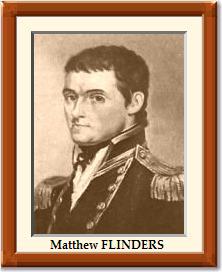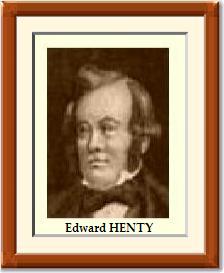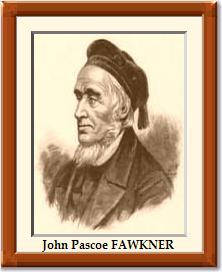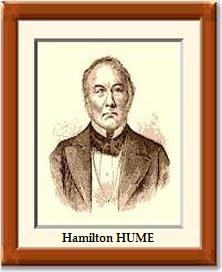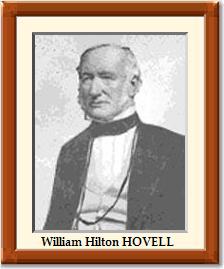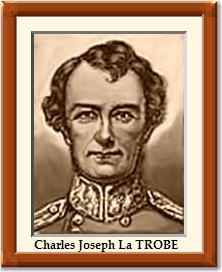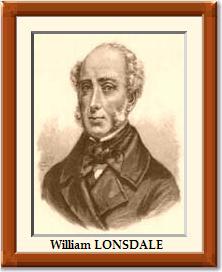Until its establishment
as a separate
colony in 1851 the area now known
as Victoria was a part of New South Wales and was generally
referred
to
as the Port Phillip district.
Two official attempts were made to found military
and
convict settlements there, but both of these proved abortive and when
permanent
settlement began it was made by private settlers from Van Diemen's Land
(Tasmania) contrary to the will of the authorities.
The
coasts of
the Port Phillip district were examined between 1798 and 1802, firstly
by George Bass, 1798 then by James
Grant, 1801 in the Lady Nelson then by John
Murray, 1802 in the Lady Nelson and then by George
Bass and Matthew Flinders, 1802 in the Investigator.
In 1803 the British Government dispatched an expedition under Lieutenant Colonel David Collins and his party in two ships sailed from Portsmouth on 27 April 1803. On board were 19 settlers, 26 settlers' wives and children, 50 marines, civil officers, 299 male convicts and 29 convicts' wives and children to found a settlement on Port Phillip, with the intention of forestalling any attempt by the French to occupy the area.
The two ships were:
HMS Calcutta was a Royal
Navy
vessel of 1200 tons carrying 50 guns under Captain
Daniel Woodriff.
The Ocean was a merchant vessel of only 481 tons
commanded
by Captain John Mertho.
It carried the civil officials, free settlers and most of the
stores
for the new colony.
Collins and his party arrived on the 7th October 1803.
They built a small settlement on the eastern side of Port
Phillip,
at Sullivan Bay, near where Sorrento stands today.
In the following weeks
Collins
reported persistently to Governor P G King in
Sydney that the area was totally unfitted for settlement.
Unfortunately, he made the mistake of settling on the east
shore
of the
bay instead of the west, and within a short time he advised
Governor
King that the place was unsuitable for a settlement. Collins
seems,
in
fact, to have exercised bad judgment in his choice of a place
for
the
settlement and to have made a very cursory examination of the
country
about Port Phillip.
Late 1803 he received permission to transfer
his party
to Van Diemen's Land.
He left Port Phillip and sailed to the Derwent River where
established
a
settlement where Hobart is now situated.
By May 1804 the settlement at Port Phillip was deserted.
After this the
district was neglected
for more than 20 years, except for
visits to the coast by whalers and sealers, many of whom were
escaped
convicts.
Meanwhile, by
1824 settlement
from Sydney had spread as far as the
headwaters of the Murrumbidgee River, and towards the close of
the
year
Hamilton Hume and William
Hilton Hovell along with Henry Angel
made an
overland journey to Port Phillip (which they took to be
Western
Port).
They brought back glowing reports of numerous rivers and fine
open
country, but the only immediate result was the establishment
of
a
military and convict post on the eastern shore of Western Port
in
December 1826.
colonizing intentions of the French, but the site chosen was again
unsuitable and the settlement was abandoned in January 1828.
However, the favourable reports of Hume and
Hovell (and
probably of
whalers and sealers) reached the settlers in Van Diemen's
Land,
where
only a limited amount of pastoral country was now available.
Inevitably the thoughts of the more adventurous were led to the
unoccupied country on the other side of Bass Strait.
In January 1827 John Batman and J. T. Gellibrand wrote from Launceston to the Governor of New South Wales, asking for permission to take up land for sheep and cattle at Western Port, but this was refused.
In
November
1834 Edward Henty, who with his father
and
brothers had reached Tasmania too late to obtain free grants of land,
took
the law
into his own hands and formed a pastoral settlement on the
shores
of
Portland Bay.
However, owing to the isolated nature of the site and the lack
of
shelter for shipping, no immediate development occurred.
Establishing the Colony at Port Phillip
In the following year John Batman also decided
to disregard
the ban on
settlement and, having carried out a somewhat farcical land
deal
with
a local tribe (June 1835), established a depot at Indented
Head
on the
western shore of Port Phillip.
the Yarra would be a suitable place for a village, John Batman returned to
Launceston to form an association known eventually as the
Port Phillip Association in order to exploit his purchase.
Meanwhile a Launceston inn-keeper and son of a convict, John Pascoe Fawkner, was also planning an expedition, which set sail in July 1835. Fawkner himself was forced, he said, by sea-sickness to miss the exploratory trip, but his party examined Western Port, found it unsuitable, and eventually settled on the banks of the River Yarra to form the nucleus of what later became Melbourne.
Foundation
Day - Melbourne and its beginnings
Melbourne was founded on Sunday, August 30, 1835, by the settlers from the
schooner Enterprize. They
landed on the north bank of the Yarra River.
The people came from Launceston in Van
Diemens Land, and they were after land for grazing sheep. They were led
by John Lancey, who was put in that position by John Pascoe Fawkner.
Fawkner owned the boat, but did not sail on its first trip into the
Port Phillip District because he was forced to stay behind because of
'sea
sickness?' and his creditors.
They picked the site because there
was a small waterfall, or rapids,
that stopped further progress up the river. The waterfall also
separated the tidal movement from fresh water at that site. The
waterfall had previously been found and noted by the Colony of New
South Wales' surveyor, Charles Grimes, in 1803.
The Enterprize was tied up
beside the north bank of the Yarra in August 1835 and the settlement of
Melbourne began.
Present to see the first settlers divide the land between
them into lots along the river and commence the first building, was the
commander of the Enterprize,
Captain Hunter, two sailors, carpenters William Jackson and Robert Hay
Marr and Evan Evans, servant to George Evans.
The schooner Enterprize
(Captain Peter Hunter) from Launceston Tasmania, reached this stretch
of the Yarra River on 29 August. On the following day Sunday 30th
August, the horses and deck cargo were unloaded.
When the Enterprize returned
to Launceston, the seven who remained were: John Lancey (master
mariner) George Evans (settler) Evan Evans (his servant) James Gilbert,
Thomas Morgan and Charles Wise (servants of J.P. Fawkner - Owner of the
schooner). Mary Gilbert (the only woman in the party) was James
Gilbert's wife gave birth on the 29th December 1835 to a son James, the
first European child born in Melbourne.
The people from the
Enterprize were our first settlers, and through their efforts Melbourne
was sited where it stands today.
Other
enterprising stock owners
from Tasmania soon followed;
by 1838 practically the whole of the present Western District
had
been
occupied and flocks numbered more than 310,000. By 1840 this
number
had more than doubled and the town on the Yarra had 4000 inhabitants,
30 hotels, 4 newspapers, and several hundred tradesmen.
The early newspapers:
The Port Phillip
Advertiser
Other newspapers
(1838 publication suppressed
1838) The Geelong Advertiser
(1840)
The Port Phillip Gazette
(1838) The Portland Garden (1842)
The Port Phillip Patriot
(1839) The Portland Mercury (1842)
The Port Phillip Herald
(1840) The Portland Bay Examiner (1845)
The Port Phillip Magazine
(1843) The Corio
Chronicle (1847)
The Port Phillip Govt Notices (1843) The
Port Fairy Gazette (1849)
The Standard
(1844)
The Warrnambool Examiner (1851)
The Port Phillip Gazetteer (1844)
The Argus (1846)
The Port Phillip Christian Herald
(1846)
The Port Phillip Christian Herald
(1846)
The Church of England Messenger (1850)
The Ham's Illustrated Magazine (1850)
The Melbourne Presbyterian Magazine
(1850)
The invasion from
Tasmania was
closely followed by waves of settlers with their herds and flocks from
the occupied districts to the north-east of
the Murray River.
A good route for over landing had been discovered by the
Surveyor
General, Major T. L. Mitchell, in 1836;
and
the settlers from New South Wales soon occupied the northern plains. As
a result of a prolonged drought in the Monaro district of New South
Wales
after 1841 a separate incursion of pastoralists followed Angus McMillan
into Gippsland.
Many shiploads of free immigrants were diverted
to
Melbourne to relieve the shortage of labour and this considerably
accelerated
development.
By the late 1840s the only parts still unoccupied were the and
areas
in
the north-west of the Mallee district and the mountainous and
heavily forested parts of Gippsland (then referred to as Gipps
Land) and
the Otway Ranges.
Port Phillip area was still unsettled in law, a tacit arrangement had been
made by which they were permitted to hold their land, but without legal
title.
To maintain order in
the new
settlement on the Yarra, Governor Sir Richard Bourke had sent a
magistrate
(Captain William Lonsdale), soldiers, and
policemen from Sydney in 1836. In March 1837 the Governor himself
visited
the Port Phillip district and directed that a town be laid out
and
named
Melbourne. In 1839 Charles
Joseph La Trobe was sent from England as
Superintendent of the Port Phillip district.
Anti transportation and Separation
The people of the Port Phillip district asserted their
desire for
independence primarily in two ways:
1. by opposition to British attempts
to
circumvent the order-in-council
(May 1840)
abolishing
transportation to New South Wales and
2. by demands for separation from New
South
Wales.
Shiploads of expirees and deportees from British
jails were
prevented from landing in Port Phillip by the solid opposition of the
townspeople,
although many squatters were in favour of accepting this cheap
labour.
With the growth of a strong anti transportation movement
during
the 1840s, the Colonial Office was forced to accept the situation and
in
1852 it
formally declared that no more convicts would be sent to the
Australian
colonies, Western Australia only being excepted. Victoria,
therefore,
through the strong independence of its urban population, never
was
in
any sense a penal colony.
Although the Port
Phillip district
was ruled from Sydney, it had its own
executive officers:
a
separate
land office
a branch
of
the Supreme Court
its own customs
and
police officers.
for independence were freely signed in Melbourne when that town was
barely five years old.
The establishment of an elective Legislative Council in New South Wales
in 1842-3 gave the Port Phillip district and Melbourne 6 of the 24 elective
seats on the Council, but this reform only increased the agitation for
independence.
Sydney was so far from Port Phillip that there was even great difficulty
in finding candidates to represent the district.
In 1848 the electors
of Melbourne
made a farce of the election by returning Lord
Grey,
an English statesman who was Secretary of State for the Colonies.
Their memorial announcing Grey's election and repeating their
demand
for
immediate separation from New South Wales was received
sympathetically
in London.
Enlightened opinion in England now maintained
that the
best way for a
colonial power to retain its empire was to let its larger
colonies
govern
themselves. And so the British
Parliament
finally agreed to separation, giving to the new colony the name of the
Queen, and fixing a boundary that ran from Cape Howe to the nearest
source
of the River Murray and then downstream to the border of South
Australia.
The Act by which Victoria was separated from
New South
Wales was an Act
"for the better Government of Her Majesty's Australian
Colonies",
August 1850, usually referred to as the Australian Colonies'
Government
Act.
When news of its passage reached Melbourne in November the
town
celebrated for almost a fortnight. A new Legislative Council created
within
the terms of the Act, comprising 20 elected members and 10 members
nominated
by the Governor, was given control of all revenue except that from
Crown
lands and could make any laws "not repugnant to the laws of England".
The influx of Chinese into Australia came about as a direct
result
of the cessation of the transportation of convicts to New South Wales
in
1840.
As the supply of cheap labour began to dwindle, anxious
employers
brought in labourers from China, a practice that was continued until
the
discovery of gold in 1851 made the undertaking unprofitable, since the
Chinese ran away to the goldfields almost as soon as they were landed.
An indication of the rapid growth of the Chinese population is
given
by the figures for the 1850s.
There were 2341 Chinese in Victoria in 1854 over 30,000 late
in
1857, and 42,000 in 1859.
In Victoria trouble broke out at an early stage on the
goldfields
of Victoria between the white miners and the Chinese. A disturbance
occurred
on the Bendigo field in June 1854, when a public meeting of Europeans
decided
that "a general and unanimous rising should take place in the various
gullies
of Bendigo on 4th July next for the purpose of driving the Chinese
population
off the Bendigo goldfields''.
Prompt action by the authorities prevented serious trouble but
it
had become obvious that drastic measures must be introduced, and in
1855
an Act designed to restrict Chinese immigration was passed.
The only effect of that legislation was to make the masters of
incoming
vessels unload their unwanted human cargoes in adjoining colonies, from
which they very soon made their way into Victoria. In the just six
months
of 1857 no fewer than 14,486 Chinese were landed in Guichen Bay (Robe),
S.A.,and their arrival on the Victorian goldfields awakened the open
resentment
of the white miners, already angered by the fact that in the previous
12
months half a million in gold had been shipped to China from
Melbourne.Again
choosing the 4th of July - a date suggesting that American miners had a
leading part in formenting the trouble -
miners held an indignation meeting at the Buckland River
goldfield
(north- eastern Victoria), and afterwards attacked the Chinese
camps,
burning and destroying property and chasing the occupants into the
bush,
where several died from exposure before police succeeded in restoring
order.
Public feeling on the Chinese question was so strong that the
ringleaders
of the riot were found not guilty at their trial.
Resentment soon abated, however, and a number of the Chinese
returned
to the field, this time protected by public opinion.
The instigators of the riot had failed in their original
purpose,
but as a result the Victorian Government entered into negotiations with
New South Wales and South Australia in an attempt to stem the influx of
Asian immigrants.
South Australia, with some realisation of the difficulties of
the
problem, complied, but New South Wales, so far unaffected by the
passage
of Chinese, would not agree.
The attitude of New South Wales towards the Chinese was
changed
by the discovery of gold in 1860 at Lambing Flat.
Trouble with Chinese on the gold fields continued into the
1870s
in Victoria, and in 1873 there was a disturbance (so-called 'Chinese
Riot')
at Clunes when mine owners attempted to use Chinese as strike breakers.
About 1000 miners set up road blocks to stop the Chinese
labourers
and their police escort from reaching the mines at Clunes.
St James (Melbourne)
The Cathedral Church of St. James, a modest wooden structure,
first
opened for worship in 1837 on the corner of Collins and William Streets.
One of the first subscribers to the fund for the erection of
the
building was
John Batman, whose generous gift made possible the first
centre
of worship for pioneer families.
It was not long, however, before moves were made for a more
permanent
church and, in 1839, soon after his arrival to take office as
Superintendent
of Port Phillip, Charles Joseph La Trobe laid the foundation stone for
the new St. James Church.
Although its first role was that of a parish church, St James
became
the Cathedral Church with the founding of the Diocese of Melbourne in
1847.
It remained as the Cathedral Church until the completion of St
Paul's
Cathedral in 1891 and was moved, stone by stone, to its present site on
the corner of King and Batman Streets, West Melbourne, in 1914.
The old Cathedral contains many features of historical
interest.
Of particular importance is the baptismal font. Made of white marble,
the
font once graced the altar of St. Katherine's Abbey that stood on the
bank
of the Thames just beyond the Tower of London.
The Abbey was demolished in 1837 and, during the demolition,
Queen
Victoria, who had ascended the throne that year, had the baptismal font
removed.
Later she sent it to Governor La Trobe who presented it to St.
James.
It is thought to be over 800 years old.
St Paul's (Melbourne)
St Paul's Cathedral is built on the site where the first
public
Christian services in Melbourne were led by Dr Alexander Thomson in
1836.
Soon afterwards a small wooden chapel was built elsewhere, and
the
area became a corn market until 1848, when it was made available for
the
building of the bluestone St Paul's Parish Church.
Consecrated in 1852, that was used until 1885, when it was
demolished
to make way for the present Cathedral.
The decision to build on the site of the existing church was
made
because of its proximity to the railway and soon to be completed cable
tramway service.
The Swanston Street and Flinders Street corner remains one of
Melbourne's
busiest intersections today, ensuring the Cathedral a place at the
heart
of city life.
By 1840, while still part of the colony of New South Wales, the pioneers of Richmond where already meeting and worshipping together.
By 1851, when Victoria became a independent colony, those pioneers had designed and built St Stephen's as it now stands.
Anglicans have been worshipping and witnessing in this historic building ever since.
St Peter's (Eastern Hill)
The first part of the building was constructed between June
18,
1846, when Charles Joseph La Trobe laid a foundation stone, and
February
1848.
During that year the first Anglican bishop
of
Melbourne, Charles Perry, had the letters
of his appointment read in the church during Morning Prayer.
The first part of the building greeted the influx of migrants
to
Melbourne who came to the colony in the wake of the gold rush.
Bluestone transepts with seating in galleries as well as at
ground
level were added, bringing the numbers that it could hold from 650 to
1050
in 1864. A further and final extension at the east end of the church
was
completed in 1876.
St Patrick's
(Eastern Hill)
In 1839 Rev Patrick Bonaventure
Geoghegan
OSF the first priest arrives in Melbourne.
On July 9, 1847 Australia Felix established as the
Diocese
of Melbourne .
The Colonial Secretary granted two acres of land for a church
on
Eastern Hill, where St Patrick's Cathedral now stands. Fr Geoghegan
establishes
St Patrick's Parish.
On October 4, 1848 the first Bishop of
Melbourne, Bishop
James Alipius Goold arrived.
April, 1850 n additional two acres of land is approved for a
bishop's
residence.
On April 9, 1850 Bishop Goold lays foundation stone of
first
(freestone) St Patrick's Church.
On February 14, 1858 Bishop Goold blesses the
first
section of the second (bluestone) St Patrick's Church and Bishop Goold
announces a cathedral is to be built for the diocese.
November of that year William Wardell commissioned to prepare
plans
for a cathedral church and work commences. On December 8 first contract
for Cathedral signed.
The first Mass was celebrated on the site in February 1858 in
a
former partially completed church, some of which was incorporated into
the south aisle of the present building; by 1868, the completed nave of
the Cathedral first served the needs of the community for regular
worship
and prayer.
EARLY PIONEERS
OF PORT PHILLIP

